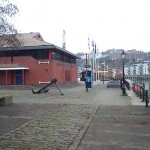
In 1970 the rusted hulk was recovered and towed back to Bristol for restoration and display. Restoration has continued from the 1970s to the present day.
I’ve visited the ship two or three times, and seen changes each time. Today’s visitor will see the innovative “waterline” glass roof which looks like water from above, but below provides a low-humidity space to conserve the hull and allow the underwater shape and propeller etc to be seen. The hull has been conserved and holes patched with fibreglass, decks have been repaired and renewed, a 1845 replica steam engine has been fitted, and replicas of various cabins and the passenger saloon have been fitted.
In addition to the ship itself, there is a museum of artefacts from the ship’s history, and a dock where other vessels are moored.
Sept 2014: No huge changes since my last visit, but there are now lifelike mannequins posed in various cabins. There is a realistic recreation of the stokehold forward of the lower engine room. The galley is fully fitted out (it even has a rat and dirty dishes), as are the steerage sleeping areas and the first-class promenade deck and dining room. In fact most of the ship is now fully fitted out to replicate its early layout and usage, with the exception of the forecastle (closed) and the forward hold (a stripped-out hole) and boiler room (a modern function space).
It looks that the ship’s boats will be added next, as replicas are on the quay-side.
Well worth a visit if you are at all interested in history, or Britain’s maritime heritage.
Finding the ship may be easier with satnav, but it is possible to find it by following the brown anchor signs. There is a pay car park – the parking meter makes one pass an IQ test on parking one’s car, entering the numeric half of the car registration. However long you park, you only have to pay £2, as you can claim the rest back when buying your Great Britain ticket.
It is possible to see the ship in about one and a half hours, but there is a historic dockside nearby that is worth a stroll.

